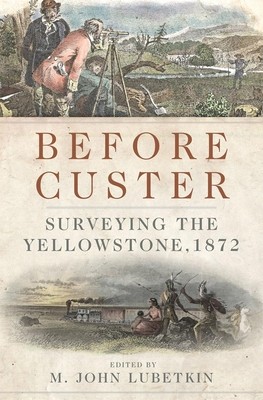
- We will send in 10–14 business days.
- Publisher: Arthur H. Clark Company
- ISBN-10: 0870624318
- ISBN-13: 9780870624315
- Format: 17.6 x 24.2 x 3.1 cm, kieti viršeliai
- Language: English
- SAVE -10% with code: EXTRA
Before Custer, Volume 33 (e-book) (used book) | bookbook.eu
Reviews
Description
Hoping to complete its transcontinental route, the Northern Pacific Railroad set out in 1872 to survey the Yellowstone Valley. An emissary from the Lakota chief Sitting Bull had warned the two surveying expeditions (eastern and western) not to enter the valley. But no one--certainly no Northern Pacific investor--was worried about taking the Indian threat seriously. As it turned out, the Indians were deadly serious--and successful. The firsthand accounts compiled here by M. John Lubetkin document the survey's three-month struggle with the Lakotas and other Plains Indian people. Before Custer: Surveying the Yellowstone, 1872 tells the story of a military and public relations disaster. Much to the surprised dismay of U.S. Army strategists and railroad executives, the Indians repeatedly harrassed army forces of nearly a thousand men. One surveying party turned back, without meeting its objectives, after a determined attack led by Sitting Bull. The other also retreated, and one ambush it encountered resulted in the death of a member of President Ulysses S. Grant's family and the narrow escape of the railroad's lead engineer. The previously unpublished documents that Lubetkin has collected and annotated also tell a parallel story: that of the dire consequences of the railroad's problems for the country. When the Northern Pacific's expansion plans were thwarted, the nation's largest private banking house failed, leading to the Panic of 1873. The fighting brought Sitting Bull to national attention and led directly to George Armstrong Custer's transfer to the Department of Dakota. The vivid eyewitness accounts artfully assembled here reveal the failures of alcoholic army commanders and show personal encounters between soldiers and Indians, among them the formidable Lakota warrior known as Gall. Before Custer tells of a little-known but crucial episode in the history of westward expansion and Native peoples' efforts to halt that expansion.
EXTRA 10 % discount with code: EXTRA
The promotion ends in 22d.02:10:43
The discount code is valid when purchasing from 10 €. Discounts do not stack.
- Publisher: Arthur H. Clark Company
- ISBN-10: 0870624318
- ISBN-13: 9780870624315
- Format: 17.6 x 24.2 x 3.1 cm, kieti viršeliai
- Language: English English
Hoping to complete its transcontinental route, the Northern Pacific Railroad set out in 1872 to survey the Yellowstone Valley. An emissary from the Lakota chief Sitting Bull had warned the two surveying expeditions (eastern and western) not to enter the valley. But no one--certainly no Northern Pacific investor--was worried about taking the Indian threat seriously. As it turned out, the Indians were deadly serious--and successful. The firsthand accounts compiled here by M. John Lubetkin document the survey's three-month struggle with the Lakotas and other Plains Indian people. Before Custer: Surveying the Yellowstone, 1872 tells the story of a military and public relations disaster. Much to the surprised dismay of U.S. Army strategists and railroad executives, the Indians repeatedly harrassed army forces of nearly a thousand men. One surveying party turned back, without meeting its objectives, after a determined attack led by Sitting Bull. The other also retreated, and one ambush it encountered resulted in the death of a member of President Ulysses S. Grant's family and the narrow escape of the railroad's lead engineer. The previously unpublished documents that Lubetkin has collected and annotated also tell a parallel story: that of the dire consequences of the railroad's problems for the country. When the Northern Pacific's expansion plans were thwarted, the nation's largest private banking house failed, leading to the Panic of 1873. The fighting brought Sitting Bull to national attention and led directly to George Armstrong Custer's transfer to the Department of Dakota. The vivid eyewitness accounts artfully assembled here reveal the failures of alcoholic army commanders and show personal encounters between soldiers and Indians, among them the formidable Lakota warrior known as Gall. Before Custer tells of a little-known but crucial episode in the history of westward expansion and Native peoples' efforts to halt that expansion.


Reviews